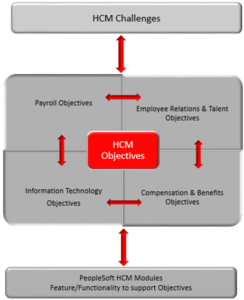With PeopleSoft 9.2 there is a lot of conversation about taking advantage of new features and functionality, de-customizing, and optimizing your solution as new features are delivered as often as quarterly. But how does an organization go about optimizing PeopleSoft? The first thing to remember is that you must treat the optimization as a project and not as a discrete activity. When you treat the optimization as a project your organization needs to:
- Define your current issues/concerns (top to bottom)
- Be specific, generate a list
- Document specific objectives that must be accomplished
- Reach a consensus & prioritize objectives
- Define & document success criteria
- What defines a successful optimization outcome?
- Generate an Executive Strategy Outline (ESO) consisting of the issues, objectives and success criteria
- Used to help prioritize projects
- Execute product reviews within PeopleSoft
- Generate a roadmap to execute optimization content that provides the largest business value and is achievable within an acceptable timeframe

Why is it important to take the time to execute in this manner?
- Executive challenges (top level) help feed downstream challenges
- Challenges help define what needs to be addressed
- Challenges are easily transformed into objectives
- Objectives are used for internal alignment and priorities
- Objectives are used to guide the PeopleSoft reviews

Once you have all the challenges and objectives defined, your organization is then ready to execute the PeopleSoft product review portion.
- Generate feature/functionality available between current image and latest available image
- Understand the objectives and use those objectives to focus on the areas in PeopleSoft to achieve those objectives
- Review current business processes
- Review current setup and configuration in PeopleSoft
- Don’t ignore opportunities to improve the end user experience
- Generate a list of opportunities
- Define the business benefit
- Define the feasibility
- Map the recommendation to the objective it helps achieve
- Prioritize
- Detailed documentation
- Project Plan to execute the various “mini” projects for optimization
By executing your optimization in this manner, your organization will be much more likely to implement changes that are most beneficial. MIPRO has a very structured process to support optimizations, if you would like additional information, please contact me at larry.zagata@miproconsulting.com.


